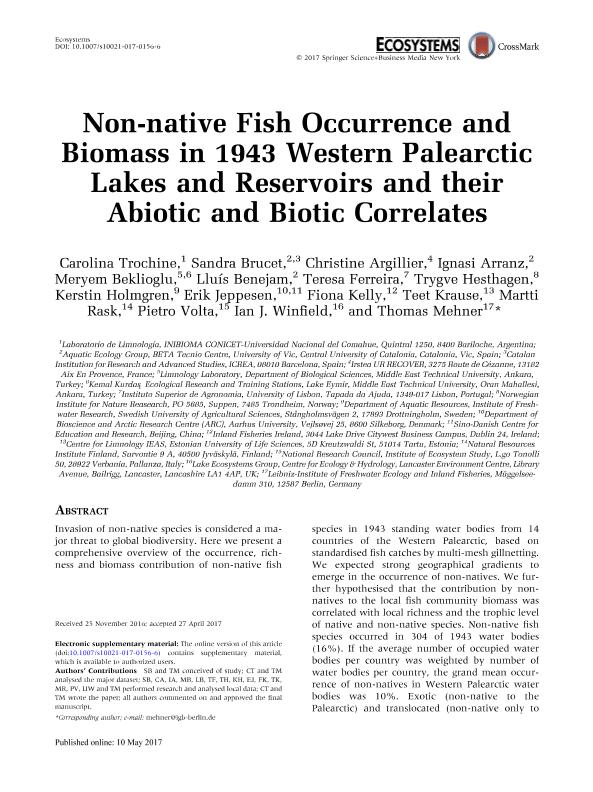Mostrar el registro sencillo del ítem
dc.contributor.author
Trochine, Carolina

dc.contributor.author
Brucet, Sandra
dc.contributor.author
Argillier, Christine
dc.contributor.author
Arranz, Ignasi
dc.contributor.author
Beklioglu, Meryem
dc.contributor.author
Benejam, Lluís
dc.contributor.author
Ferreira, Teresa
dc.contributor.author
Hesthagen, Trygve
dc.contributor.author
Holmgren, Kerstin
dc.contributor.author
Jeppesen, Erik
dc.contributor.author
Kelly, Fiona
dc.contributor.author
Krause, Teet
dc.contributor.author
Rask, Martti
dc.contributor.author
Volta, Pietro
dc.contributor.author
Winfield, Ian J.
dc.contributor.author
Mehner, Thomas
dc.date.available
2018-09-11T18:01:05Z
dc.date.issued
2018-04-10
dc.identifier.citation
Trochine, Carolina; Brucet, Sandra; Argillier, Christine; Arranz, Ignasi; Beklioglu, Meryem; et al.; Non-native Fish Occurrence and Biomass in 1943 Western Palearctic Lakes and Reservoirs and their Abiotic and Biotic Correlates; Springer; Ecosystems; 21; 3; 10-4-2018; 395-409
dc.identifier.issn
1432-9840
dc.identifier.uri
http://hdl.handle.net/11336/59123
dc.description.abstract
Invasion of non-native species is considered a major threat to global biodiversity. Here we present a comprehensive overview of the occurrence, richness and biomass contribution of non-native fish species in 1943 standing water bodies from 14 countries of the Western Palearctic, based on standardised fish catches by multi-mesh gillnetting. We expected strong geographical gradients to emerge in the occurrence of non-natives. We further hypothesised that the contribution by non-natives to the local fish community biomass was correlated with local richness and the trophic level of native and non-native species. Non-native fish species occurred in 304 of 1943 water bodies (16%). If the average number of occupied water bodies per country was weighted by number of water bodies per country, the grand mean occurrence of non-natives in Western Palearctic water bodies was 10%. Exotic (non-native to the Palearctic) and translocated (non-native only to parts of the Palearctic) species were found in 164 (8.4%) or 235 (12.1%) of the water bodies, respectively. The occurrence and local richness of non-native fish species increased with temperature, precipitation and lake area and were substantially higher in reservoirs than in natural lakes. High local biomass contributions of non-native species were strongly correlated with low richness of native species and high richness of non-native species, whereas the trophic level of the fish species had only a weak effect. Single non-native species rarely dominated community biomass, but high biomass contributions and thus strong community and ecosystem impacts can be expected if several non-native species accumulate in a water body.
dc.format
application/pdf
dc.language.iso
eng
dc.publisher
Springer

dc.rights
info:eu-repo/semantics/openAccess
dc.rights.uri
https://creativecommons.org/licenses/by-nc-sa/2.5/ar/
dc.subject
Exotic Species
dc.subject
Invasion Biology
dc.subject
Invasion Meltdown
dc.subject
Lake Fish Communities
dc.subject
Translocated Species
dc.subject
Trophic Similarity
dc.subject.classification
Otras Ciencias Biológicas

dc.subject.classification
Ciencias Biológicas

dc.subject.classification
CIENCIAS NATURALES Y EXACTAS

dc.title
Non-native Fish Occurrence and Biomass in 1943 Western Palearctic Lakes and Reservoirs and their Abiotic and Biotic Correlates
dc.type
info:eu-repo/semantics/article
dc.type
info:ar-repo/semantics/artículo
dc.type
info:eu-repo/semantics/publishedVersion
dc.date.updated
2018-08-31T13:48:34Z
dc.journal.volume
21
dc.journal.number
3
dc.journal.pagination
395-409
dc.journal.pais
Alemania

dc.journal.ciudad
Berlín
dc.description.fil
Fil: Trochine, Carolina. Consejo Nacional de Investigaciones Científicas y Técnicas. Centro Científico Tecnológico Conicet - Patagonia Norte. Instituto de Investigaciones en Biodiversidad y Medioambiente. Universidad Nacional del Comahue. Centro Regional Universidad Bariloche. Instituto de Investigaciones en Biodiversidad y Medioambiente; Argentina. Universidad Nacional del Comahue. Centro Regional Universitario Bariloche. Laboratorio de Limnología; Argentina
dc.description.fil
Fil: Brucet, Sandra. University of Vic; España. Catalan Institution for Research and Advanced Studies; España. Institució Catalana de Recerca i Estudis Avancats; España
dc.description.fil
Fil: Argillier, Christine. Aix En Provence; Francia
dc.description.fil
Fil: Arranz, Ignasi. University of Vic; España
dc.description.fil
Fil: Beklioglu, Meryem. Middle East Technical University; Turquía
dc.description.fil
Fil: Benejam, Lluís. University of Vic; España
dc.description.fil
Fil: Ferreira, Teresa. Universidade de Lisboa; Portugal
dc.description.fil
Fil: Hesthagen, Trygve. Norwegian Institute for Nature Reasearch; Noruega
dc.description.fil
Fil: Holmgren, Kerstin. Swedish University of Agricultural Sciences; Suecia
dc.description.fil
Fil: Jeppesen, Erik. Sino-danish Centre For Education And Research; China. University Aarhus; Dinamarca
dc.description.fil
Fil: Kelly, Fiona. Inland Fisheries Ireland; Irlanda
dc.description.fil
Fil: Krause, Teet. Estonian University of Life Sciences; Estonia
dc.description.fil
Fil: Rask, Martti. Natural Resources Institute Finland; Finlandia
dc.description.fil
Fil: Volta, Pietro. Consiglio Nazionale delle Ricerche; Italia
dc.description.fil
Fil: Winfield, Ian J.. Lancaster Environment Centre; Reino Unido
dc.description.fil
Fil: Mehner, Thomas. Leibniz - Institute of Freshwater Ecology and Inland Fisheries; Alemania
dc.journal.title
Ecosystems

dc.relation.alternativeid
info:eu-repo/semantics/altIdentifier/doi/https://dx.doi.org/10.1007/s10021-017-0156-6
dc.relation.alternativeid
info:eu-repo/semantics/altIdentifier/url/https://link.springer.com/article/10.1007%2Fs10021-017-0156-6
Archivos asociados
